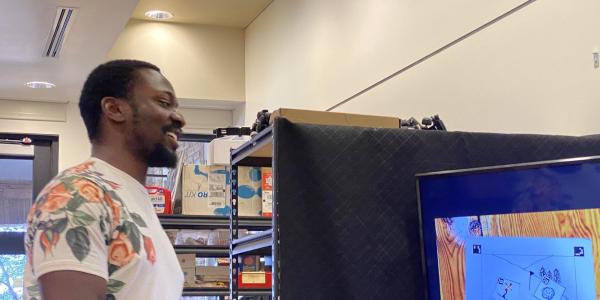
Centrally located in the Smithsonian Institute’s new “Futures” exhibition in Washington D.C. is an interactive light sculpture designed by acclaimed New York artist and architect Suchi Reddy, with support from a team of creative technologists that includes renowned multimedia artist and Creative Technology and Design program Lecturer Justin Gitlin.
Called “me + you,” the two-story sculpture invites visitors to say a word into one of nine "mandalas" that describes their future. Based on the word used and tonal qualities of the visitor’s voice, software designed by Gitlin interfaces with an Amazon Web Services machine learning algorithm to generate a dynamic light display on the mandala, representing the individual’s description of their future.
Meanwhile, the sculpture’s upper lighting represents all visitors’ collective future visions.
As a member of Hovercraft Studio, Gitlin also helped develop the project’s website, which let site visitors remotely influence the sculpture’s colors by entering a word that describes their visions of the future.
Gitlin's work with Reddy’s and Hovercraft’s creative teams included planning and building the human-computer interactions and the graphics software that powers the 3D animations across 10,000 LED lights. The creative team specced, acquired and installed 10 computers, nine Arduinos, nine microphones and an accessible touchscreen, all of which come together to control the sculpture’s appearance moment to moment. Gitlin said he spent a significant amount of time collaborating with the lighting design to ensure each of the 10,000 LED pixels were mapped and functioning properly, and that colors generated across different types of LED lights were consistent.
“I made a variety of contributions to the creative direction of the project. The process of realizing Suchi's vision and Hovercraft's collective interpretation of that vision involved prototyping concepts, simulating them in 3D, and iterating until they felt right and fit with the creative goals of the piece,” said Gitlin.
Gitlin came to the Smithsonian project by way of a series of Nike-sponsored retail installations he’s collaborated on for the design and fabrication company, Bednark.
After being invited to help build Suchi’s sculpture, Bednark brought in Hovercraft to help conceptualize and build the sculpture’s digital functionality. Given Gitlin’s skills in interaction design and generative installations, it was clear that he could contribute more to the project by joining Hovercraft’s team.
The Futures exhibition is located in the historic Arts and Industries Building, the Smithsonian’s second oldest structure, which opened in 1881. Interestingly, the light sculpture is located in the building’s rotunda where, in 1881 when the building opened, many people would have had their first glimpse of Edison's light bulb.
Can't make it to D.C. but intrigued by the idea of interactive light-based art? Closer to home, Gitlin's solo exhibition runs through February at the Old Masonic Hall in Breckenridge.





